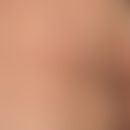Synonym(s)
HistoryThis section has been translated automatically.
Baumeister FA et al. 1993
DefinitionThis section has been translated automatically.
Rare, familial variant of generalized hypertrichosis. So far, about 50 patients and families with Ambras syndrome are known.
You might also be interested in
EtiopathogenesisThis section has been translated automatically.
Autosomal dominant inheritance. Pathogenetically, persistence and excessive growth of vellus hairs are assumed. S.a. Hypertrichosis lanuginosa congenita (persistence of lanugo hairs). It is based on a molecular defect with a chromsomal inversion fracture at 8p11.2 and 8q23.1, inv (8) (p11.2q23.1). It was shown that the fracture sites are not located in a coding region of the chromosome. There is a so-called position effect on the TRPSI gene.
ClinicThis section has been translated automatically.
At the entire Integument, including the face and the ears, there are up to 25 cm long, dense, silky body hairs. Palms, soles of the feet, lips and prepuce remain free.
While the excessively growing vellus hairs are not replaced by terminal hairs in most regions, terminal hair transformation of the axillary and pubic hairs occurs after puberty, in men also in the face. Frequently deficient dentition, facial dysmorphia with hypertelorism, wide cleft eyelids, shortened lower lip.
Often cranial dysmorphia, as well as hexadactyly and polythelia are also found. Endocrinological disorders are absent.
The affected individuals have gained a dubious fame, as they were publicly displayed as wolf-men at fairs.
Differential diagnosisThis section has been translated automatically.
Note(s)This section has been translated automatically.
LiteratureThis section has been translated automatically.
Baumeister FA et al (1993) Ambras syndrome: delineation of a unique hypertrichosis universalis congenita andassociation
with a balanced pericentric inversion (8) (p11.2; q22). Clin Genet44:121-128.Frank J et al (2013) Genetic hair diseases. To update. Dermatologist 64: 830-842.
Trueb RM (2008) Hypertrichosis. Dermatologist 59: 325-338
Incoming links (1)
Gingival fibromatosis-hypertrichosis syndrome;Outgoing links (1)
X-linked congenital generalized hypertrichosis;Disclaimer
Please ask your physician for a reliable diagnosis. This website is only meant as a reference.




